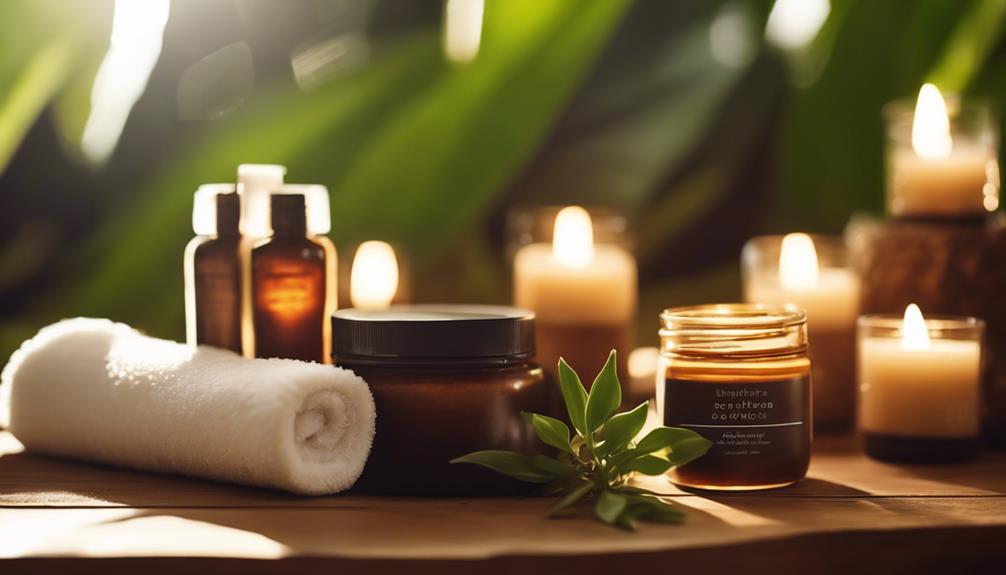You can obtain a sun-kissed glow without using tanning beds by trying out safe alternatives. Self-tanners, such as lotions and sprays, contain dihydroxyacetone for a natural appearance, while spray tanning booths provide a quick, professional finish. Gradual tanning moisturizers hydrate your skin while gradually developing color. To ensure an even application, exfoliate beforehand and moisturize dry areas. Remember to use a tanning mitt for streak-free results. With a variety of options available, you can enhance your glow while safeguarding your skin’s health. Discover more about these safe techniques and products. Experiment with different self-tanning formulas to find the best match for your skin type and desired shade. Whether you prefer a subtle hint of color or a deeper tan, there are products designed to help you achieve a radiant tanning glow without the damaging effects of UV exposure. Maintain healthy and radiant skin all year long with these reliable and safe alternatives.
Key Takeaways
- Self-tanning products like lotions and sprays provide a bronzed look without the harmful UV exposure of tanning beds.
- Gradual tanning moisturizers nourish skin while building a natural-looking tan over time.
- Professional spray tanning booths offer quick, even applications that last up to two weeks.
- Temporary bronzing lotions with SPF enhance color while protecting skin from sun damage.
Benefits of Safe Tanning Alternatives
Choosing safe tanning alternatives, like self-tanners and spray tans, not only protects your skin from harmful UV damage but also allows you to achieve a gorgeous glow without the risks associated with tanning beds. When looking for safe tanning alternatives, it’s also important to consider using the best tanning lotions that provide a natural-looking tan. These lotions contain ingredients that are designed to mimic the effects of the sun without the potential harm. Additionally, using these products can help keep your skin moisturized and healthy, giving you a beautiful tan without compromising your skin’s well-being.
These methods deliver instant color, giving you that sun-kissed look while maintaining your skin's health.
Spray tanning booths offer a convenient, professional application, ensuring an even tan that lasts for days.
You can also opt for tinted lotions that combine hydration with color, enhancing your natural beauty.
Embracing these safer options means you can feel confident and stylish without compromising your skin's integrity.
Overview of Self-Tanning Products

Self-tanning products, like lotions and sprays, offer a safe and effective way to achieve a sun-kissed glow without exposing your skin to harmful UV rays. These products typically use dihydroxyacetone (DHA), which reacts with your skin to create a natural-looking tan.
If you're short on time, consider spray tanning booths for a quick, professional application that lasts from weekends to weeks. For a more gradual approach, gradual tanning moisturizers build color over time while keeping your skin hydrated.
You can also opt for natural bronzers for an easy and quick application. With so many options available, you can find the perfect self-tanning product to achieve a beautiful, bronzed look safely and effectively.
Best Practices for Healthy Tanning

To achieve a beautiful tan while prioritizing skin health, it's essential to follow best practices that minimize damage and enhance your glow. Start by exfoliating your skin before applying any self-tanner to guarantee an even application. Use a moisturizer to hydrate your skin, which can help the color develop more uniformly. Always choose products with natural ingredients and SPF to protect your skin while tanning. Reapply self-tanner as needed to maintain your desired shade. Finally, remember that patience is key; gradual tanners provide a more natural look without the risks of overexposure.
| Best Practices | Description |
|---|---|
| Exfoliate | Prepares skin for even application |
| Moisturize | Hydrates skin for better color |
| Use SPF | Protects skin during tanning |
| Reapply as needed | Maintains desired shade |
| Be patient | Achieve a natural look gradually |
Exploring Faux Glow Options

Exploring various faux glow options can help you achieve a radiant tan without the risks associated with UV exposure. These products allow you to enhance your skin's appearance safely and effectively.
Here are some popular choices to weigh:
- Self-tanning lotions: Apply these for a sun-kissed look that develops gradually, giving you control over the intensity.
- Spray tanning booths: Enjoy a professional application that delivers an even, natural-looking tan lasting up to a week.
Natural Tanning Techniques

Natural tanning techniques offer additional ways to achieve that desired glow while emphasizing skin health and safety.
You can explore self-tanning products, which provide a bronzed appearance without harmful UV exposure. Options like wash-off bronzers are perfect for a temporary, low-commitment tan, allowing you to enjoy a sun-kissed look without long-term effects.
Gradual tanning moisturizers can also build color over time, giving you a subtle glow while nourishing your skin.
Additionally, embracing your natural skin tone remains stylish, promoting a healthy, radiant appearance.
By prioritizing skin health and experimenting with various tanning methods, you can confidently enhance your glow without compromising safety or risking skin damage.
Immerse yourself in these techniques and enjoy the benefits they offer!
Tips for Effective Application

Achieving a flawless tan requires careful preparation and application techniques to guarantee even coverage and a natural look. To make the most of your self-tanning products, follow these essential tips:
Exfoliate your skin: Start with a gentle scrub to remove dead skin cells, ensuring a smooth base for the tanner.
Moisturize dry areas: Apply a light moisturizer to elbows, knees, and ankles, preventing those areas from absorbing too much product.
Apply evenly: Use a tanning mitt for a streak-free finish, blending the product in circular motions for a seamless look.
Trending Insights in Tanning Choices

Current trends in tanning choices highlight a growing preference for safe, sunless options that prioritize skin health while providing a beautiful glow. Many people are now opting for self-tanners, spray tans, and natural bronzers instead of traditional tanning beds.
Here's a quick comparison of popular tanning options:
| Tanning Method | Duration of Tan | Skin Safety |
|---|---|---|
| Self-Tanning Lotions | 5-7 days | High |
| Spray Tans | 1-2 weeks | Very High |
| Gradual Tanners | Varies (builds over time) | High |
| Natural Bronzers | Washes off easily | High |
| Tanning Booths | 1-2 weeks | Very High |
With these options, you can achieve a gorgeous tan while keeping your skin healthy and protected.
Frequently Asked Questions
Can Self-Tanners Cause Allergic Reactions on Sensitive Skin?
Yes, self-tanners can cause allergic reactions on sensitive skin. It's important to patch-test products before full application. If irritation occurs, discontinue use and consult a dermatologist for safer alternatives tailored to your skin type.
How Long Do Self-Tanners Typically Last Before Fading?
Self-tanners typically last about five to seven days before fading, depending on your skin type and maintenance. Exfoliating and moisturizing regularly can help prolong the color, keeping your glow looking fresh and vibrant longer.
Are Self-Tanning Products Suitable for All Skin Tones?
Self-tanning products work like magic wands, transforming your skin tone effortlessly. They're suitable for all skin tones, but testing a small area first guarantees the best results for your unique complexion. Enjoy the glow!
What Ingredients Should I Avoid in Self-Tanning Products?
When choosing self-tanning products, avoid ingredients like parabens, synthetic fragrances, and alcohol. They can irritate your skin and lead to uneven results. Always check labels to verify you're getting the safest, most effective products.
Can I Use Self-Tanner on My Face Safely?
Yes, you can safely use self-tanner on your face. Just choose a product specifically formulated for facial skin, patch test first, and remember to blend well for an even, natural-looking glow.
Conclusion
Incorporating safe tanning alternatives into your routine not only enhances your glow but also protects your skin.
Did you know that over 90% of skin cancers are linked to UV exposure?
By opting for self-tanners, gradual moisturizers, or tinted sunscreens, you can achieve that sun-kissed look without the risks associated with tanning beds.
Embrace these healthier choices and enjoy a radiant complexion while keeping your skin safe.
Your skin will truly appreciate the care!









